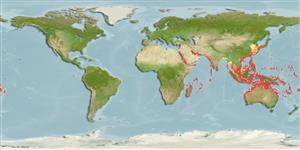Actinopterygii (ray-finned fishes) >
Perciformes (Perch-likes) >
Carangidae (Jacks and pompanos) > Caranginae
Etymology: Carangoides: French, carangue, the name of a Caribbean fish; 1836 (Ref. 45335).
Environment / Climate / Range
Ecology
Marine; reef-associated; depth range ? - 100 m (Ref. 9710). Tropical, preferred 28°C (Ref. 107945); 36°N - 30°S, 32°E - 174°W
Indo-West Pacific: Red Sea and the East Africa to Palau and New Caledonia, north to Ryukyu and Ogasawara islands (Ref. 559, 26066), south to Australia. Recently reported from Tonga (Ref. 53797).
Size / Weight / Age
Maturity: Lm ? range ? - ? cm
Max length : 120 cm FL male/unsexed; (Ref. 3678); common length : 90.0 cm TL male/unsexed; (Ref. 5450); max. published weight: 18.0 kg (Ref. 3287)
Adults prefer rocky and coral reef areas, but also found on offshore banks (Ref. 30573). They are found singly or in small to large schools (Ref. 9710, 48635, 90102). They feed on small invertebrates and fishes (Ref. 5213).
Life cycle and mating behavior
Maturity | Reproduction | Spawning | Eggs | Fecundity | Larvae
Paxton, J.R., D.F. Hoese, G.R. Allen and J.E. Hanley, 1989. Pisces. Petromyzontidae to Carangidae. Zoological Catalogue of Australia, Vol. 7. Australian Government Publishing Service, Canberra, 665 p. (Ref. 7300)
IUCN Red List Status (Ref. 115185)
CITES (Ref. 94142)
Not Evaluated
Threat to humans
Harmless
Human uses
Fisheries: commercial; gamefish: yes
More information
Common namesSynonymsMetabolismPredatorsEcotoxicologyReproductionMaturitySpawningFecundityEggsEgg development
ReferencesAquacultureAquaculture profileStrainsGeneticsAllele frequenciesHeritabilityDiseasesProcessingMass conversion
Tools
Special reports
Download XML
Internet sources
